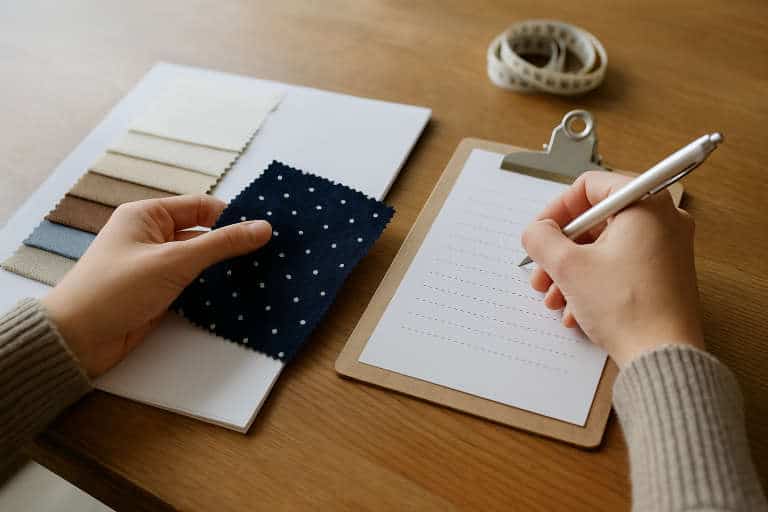A Down-to-Earth Guide for Beginners
Let’s not pretend it’s easy. Buying fabric online for the first time is… well, odd. You’re making a decision about colour, texture, weight and feel without actually being able to see, touch or drape the fabric in real life. It’s like picking a meal off a menu without knowing what half the ingredients taste like.
But buying fabric online is also convenient. And once you get the hang of it, it’s incredibly satisfying.
So if you’re new to the world of buying fabric online, or maybe you’ve had a few less-than-perfect experiences, this guide will help you build confidence and avoid those “what was I thinking?” moments.

Start Small, Think Smart
One of the most helpful buying fabric online? Don’t go all-in on a fabric you’ve never used before. Tempting as it might be to fill your basket during a sale, stick to a metre or two if you’re trying something new. You can always go back and buy more once you’ve had a feel of it.
“I think the bow could be bigger!”
Esme Young
This simple shift can save you from ending up with five metres of something that looks stunning on screen but feels like a beach towel when it arrives. Especially when you’re buying fabric online, this approach helps you stay in control.
How to Avoid Buying Mistakes
This deserves a section of its own because nearly everyone has made at least one. Here’s how to dodge the common traps:
- Always double-check the width of the fabric. It affects how much you need and can completely throw your measurements off if you miss it.
- Read care instructions before you buy. That delicate viscose might shrink or need hand-washing, fine if you’re prepared, not great if you’re not.
- Watch out for screen colours. What looks like dusty pink on your laptop might turn out more salmon in daylight. If it needs to match something, order a swatch.
- Don’t ignore words like “sheer”, “structured”, or “drapey”. They really do mean something in practice. If you’re unsure, treat those as clues.
- Lastly, listen to your pattern. If it says viscose or jersey, it means it. Swapping in a crisp cotton might sound harmless but can completely change the fit and hang of your garment.
Understand Fabric Types
You don’t need to know everything. Just enough to know what kind of fabric matches what kind of garment. Here’s a quick sewing fabric guide to get started:
- Jersey – Soft and stretchy. Ideal for relaxed tees, lounge trousers or comfy dresses.
- Linen – Airy and slightly textured. Perfect for summer tunics and casual trousers.
- Viscose – Smooth, fluid, and elegant. Great for garments with movement like skirts and wraps.
- Wool – Thick and warm. Think coats, winter skirts, or a good old-fashioned cape.
- Cotton poplin or lawn – Crisp, light, and versatile. Ideal for shirts, tops, and dresses that need structure.
- Chambray and denim – Tougher but wearable. Useful for pinafores, jeans or utility-style garments.
- Tencel modal jersey – Silky-soft and breathable with a gentle stretch. Perfect for layering pieces, soft draping tops, or comfortable dresses.
When buying fabric online, you’ll get better at choosing as you go. The first few times are more about noticing the differences and getting a feel for what you like.
Descriptions Matter More Than You’d Think

Some websites copy-paste whatever the manufacturer says. Others, usually the ones worth buying from, write their own descriptions. This is where you can learn a lot.
A good product description should tell you:
Those little notes can be surprisingly reassuring, especially when they’re written by someone who has actually handled the fabric.
Match the Fabric to the Pattern
“Never forget the material you are working with, and try always to use it for doing what it can do best.”
William Morris
We’ve all been there. You fall in love with a fabric, imagine the gorgeous dress you’re going to make, and then, realise the fabric is all wrong for the pattern. Or worse, you push on, make it anyway, and end up with a stiff, shapeless mess.
The golden rule is this: check your pattern for recommended fabrics. A design intended for drapey viscose simply won’t look right in crisp cotton. And if you’re buying fabric online, always pause to double-check this before clicking buy.
The Magic of Swatches
Swatches aren’t exciting. But they’re useful.
They’re especially handy when:
- You’re trying a new fabric you haven’t used before
- You need to match a particular colour or lining
- You’re comparing two or three fabrics and can’t decide
It’s a tiny square, but sometimes that’s all you need to make a confident choice. It turns your guess into a decision, especially when buying fabric online where pictures alone can’t tell the full story.
Don’t Forget the Other Bits
Sewing isn’t just fabric. You’ll often need matching thread, zips, elastic, interfacing, lining, maybe even buttons.
It’s easy to overlook these things in the excitement of finding the perfect fabric. But if your order arrives and you realise you’ve forgotten to buy the zip, or don’t have matching thread, it can really slow you down. Some shops let you add matching extras right on the fabric page.
What Is Fabric Weight and Why Does It Matter?
Fabric weight tells you how heavy the material is, measured in gsm (grams per square metre). It’s more than just numbers, it helps you predict how the fabric will behave. Understanding fabric weight is a big part of how to choose fabric wisely.
- 60 to 150gsm – Floaty dresses, linings, and breezy shirts
- 150 to 250gsm – Most everyday clothing like skirts, button-ups, and trousers
- 250gsm and over – Structure: jackets, coats, upholstery-type projects
Ask Questions
If you’re not sure whether a fabric will work for a certain pattern, or you’re hesitating between two options, just ask. Good fabric shops will happily help.
And if they seem snooty or uninterested? Find another shop. There are plenty out there who genuinely care.
What Makes Buying Fabric Online Worth It
There’s something oddly rewarding about getting it right. When that parcel arrives, you open it up and realise, yes, this is exactly what I hoped for.
Buying fabric online gives you access to a much wider selection than you’ll ever find in a high street shop. You can discover independent designers, ex-designer deadstock, or niche prints that never show up in person.
Yes, there’s a learning curve. And yes, you might make a few mistakes early on. But the longer you do it, the more confident you’ll get. Eventually, you’ll develop a kind of instinct. The photos and descriptions will start to tell you more than you realised before. And in time, you’ll have your own go-to methods for buying fabric online, understanding texture, and trusting your gut. That’s the magic of buying fabric online, you get better with every click.